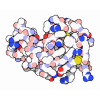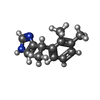[English] 日本語
 Yorodumi
Yorodumi- PDB-9cbm: Cryo-EM structure of dexmedetomidine-bound alpha-2A-adrenergic re... -
+ Open data
Open data
- Basic information
Basic information
| Entry | Database: PDB / ID: 9cbm | ||||||
|---|---|---|---|---|---|---|---|
| Title | Cryo-EM structure of dexmedetomidine-bound alpha-2A-adrenergic receptor in complex with heterotrimeric Gi-protein | ||||||
 Components Components |
| ||||||
 Keywords Keywords | SIGNALING PROTEIN / GPCR Adrenergic Receptor | ||||||
| Function / homology |  Function and homology information Function and homology informationnegative regulation of uterine smooth muscle contraction / adenylate cyclase-inhibiting adrenergic receptor signaling pathway / alpha2-adrenergic receptor activity / Adrenaline signalling through Alpha-2 adrenergic receptor / alpha-2C adrenergic receptor binding / epinephrine binding / phospholipase C-activating adrenergic receptor signaling pathway / alpha-1B adrenergic receptor binding / Extra-nuclear estrogen signaling / negative regulation of norepinephrine secretion ...negative regulation of uterine smooth muscle contraction / adenylate cyclase-inhibiting adrenergic receptor signaling pathway / alpha2-adrenergic receptor activity / Adrenaline signalling through Alpha-2 adrenergic receptor / alpha-2C adrenergic receptor binding / epinephrine binding / phospholipase C-activating adrenergic receptor signaling pathway / alpha-1B adrenergic receptor binding / Extra-nuclear estrogen signaling / negative regulation of norepinephrine secretion / Adenylate cyclase inhibitory pathway / negative regulation of epinephrine secretion / Olfactory Signaling Pathway / Sensory perception of sweet, bitter, and umami (glutamate) taste / Synthesis, secretion, and inactivation of Glucagon-like Peptide-1 (GLP-1) / heterotrimeric G-protein binding / negative regulation of calcium ion-dependent exocytosis / Activation of the phototransduction cascade / Surfactant metabolism / positive regulation of potassium ion transport / dopaminergic synapse / thermoception / fear response / thioesterase binding / negative regulation of insulin secretion involved in cellular response to glucose stimulus / negative regulation of synaptic transmission / GTPase activating protein binding / Adrenaline,noradrenaline inhibits insulin secretion / positive regulation of membrane protein ectodomain proteolysis / ADP signalling through P2Y purinoceptor 12 / norepinephrine binding / Adrenoceptors / G alpha (i) signalling events / response to alcohol / intestinal absorption / Activation of G protein gated Potassium channels / G-protein activation / G beta:gamma signalling through PI3Kgamma / Prostacyclin signalling through prostacyclin receptor / G beta:gamma signalling through PLC beta / ADP signalling through P2Y purinoceptor 1 / Thromboxane signalling through TP receptor / Presynaptic function of Kainate receptors / G beta:gamma signalling through CDC42 / Inhibition of voltage gated Ca2+ channels via Gbeta/gamma subunits / G alpha (12/13) signalling events / Glucagon-type ligand receptors / G beta:gamma signalling through BTK / ADP signalling through P2Y purinoceptor 12 / Adrenaline,noradrenaline inhibits insulin secretion / Cooperation of PDCL (PhLP1) and TRiC/CCT in G-protein beta folding / positive regulation of epidermal growth factor receptor signaling pathway / Ca2+ pathway / Thrombin signalling through proteinase activated receptors (PARs) / G alpha (z) signalling events / Extra-nuclear estrogen signaling / response to morphine / G alpha (s) signalling events / G alpha (q) signalling events / positive regulation of wound healing / neurotransmitter receptor localization to postsynaptic specialization membrane / adrenergic receptor signaling pathway / G alpha (i) signalling events / Glucagon-like Peptide-1 (GLP1) regulates insulin secretion / High laminar flow shear stress activates signaling by PIEZO1 and PECAM1:CDH5:KDR in endothelial cells / Vasopressin regulates renal water homeostasis via Aquaporins / negative regulation of calcium ion transport / regulation of vasoconstriction / negative regulation of lipid catabolic process / viral release from host cell by cytolysis / cellular response to hormone stimulus / positive regulation of protein localization to cell cortex / Rho protein signal transduction / T cell migration / adenylate cyclase-activating adrenergic receptor signaling pathway / D2 dopamine receptor binding / response to prostaglandin E / presynaptic active zone membrane / adenylate cyclase regulator activity / G protein-coupled serotonin receptor binding / adenylate cyclase-inhibiting serotonin receptor signaling pathway / peptidoglycan catabolic process / axon terminus / presynaptic modulation of chemical synaptic transmission / cellular response to forskolin / regulation of mitotic spindle organization / guanyl-nucleotide exchange factor activity / positive regulation of cytokine production / positive regulation of cholesterol biosynthetic process / female pregnancy / negative regulation of insulin secretion / G protein-coupled receptor binding / adenylate cyclase-inhibiting G protein-coupled receptor signaling pathway / postsynaptic density membrane / GABA-ergic synapse / platelet activation / adenylate cyclase-modulating G protein-coupled receptor signaling pathway / G-protein beta/gamma-subunit complex binding / vasodilation / adenylate cyclase-activating G protein-coupled receptor signaling pathway Similarity search - Function | ||||||
| Biological species |    Enterobacteria phage T4 (virus) Enterobacteria phage T4 (virus) Homo sapiens (human) Homo sapiens (human) | ||||||
| Method | ELECTRON MICROSCOPY / single particle reconstruction / cryo EM / Resolution: 3.2 Å | ||||||
 Authors Authors | Lou, J.S. / Su, M. / Wang, J. / Do, H.N. / Miao, Y. / Huang, X.Y. | ||||||
| Funding support |  United States, 1items United States, 1items
| ||||||
 Citation Citation |  Journal: Exp Mol Med / Year: 2024 Journal: Exp Mol Med / Year: 2024Title: Distinct binding conformations of epinephrine with α- and β-adrenergic receptors. Authors: Jian-Shu Lou / Minfei Su / Jinan Wang / Hung Nguyen Do / Yinglong Miao / Xin-Yun Huang /   Abstract: Agonists targeting α-adrenergic receptors (ARs) are used to treat diverse conditions, including hypertension, attention-deficit/hyperactivity disorder, pain, panic disorders, opioid and alcohol ...Agonists targeting α-adrenergic receptors (ARs) are used to treat diverse conditions, including hypertension, attention-deficit/hyperactivity disorder, pain, panic disorders, opioid and alcohol withdrawal symptoms, and cigarette cravings. These receptors transduce signals through heterotrimeric Gi proteins. Here, we elucidated cryo-EM structures that depict α-AR in complex with Gi proteins, along with the endogenous agonist epinephrine or the synthetic agonist dexmedetomidine. Molecular dynamics simulations and functional studies reinforce the results of the structural revelations. Our investigation revealed that epinephrine exhibits different conformations when engaging with α-ARs and β-ARs. Furthermore, α-AR and β-AR (primarily coupled to Gs, with secondary associations to Gi) were compared and found to exhibit different interactions with Gi proteins. Notably, the stability of the epinephrine-α-AR-Gi complex is greater than that of the dexmedetomidine-α-AR-Gi complex. These findings substantiate and improve our knowledge on the intricate signaling mechanisms orchestrated by ARs and concurrently shed light on the regulation of α-ARs and β-ARs by epinephrine. | ||||||
| History |
|
- Structure visualization
Structure visualization
| Structure viewer | Molecule:  Molmil Molmil Jmol/JSmol Jmol/JSmol |
|---|
- Downloads & links
Downloads & links
- Download
Download
| PDBx/mmCIF format |  9cbm.cif.gz 9cbm.cif.gz | 169.1 KB | Display |  PDBx/mmCIF format PDBx/mmCIF format |
|---|---|---|---|---|
| PDB format |  pdb9cbm.ent.gz pdb9cbm.ent.gz | 122.5 KB | Display |  PDB format PDB format |
| PDBx/mmJSON format |  9cbm.json.gz 9cbm.json.gz | Tree view |  PDBx/mmJSON format PDBx/mmJSON format | |
| Others |  Other downloads Other downloads |
-Validation report
| Summary document |  9cbm_validation.pdf.gz 9cbm_validation.pdf.gz | 1.3 MB | Display |  wwPDB validaton report wwPDB validaton report |
|---|---|---|---|---|
| Full document |  9cbm_full_validation.pdf.gz 9cbm_full_validation.pdf.gz | 1.4 MB | Display | |
| Data in XML |  9cbm_validation.xml.gz 9cbm_validation.xml.gz | 36.2 KB | Display | |
| Data in CIF |  9cbm_validation.cif.gz 9cbm_validation.cif.gz | 52.4 KB | Display | |
| Arichive directory |  https://data.pdbj.org/pub/pdb/validation_reports/cb/9cbm https://data.pdbj.org/pub/pdb/validation_reports/cb/9cbm ftp://data.pdbj.org/pub/pdb/validation_reports/cb/9cbm ftp://data.pdbj.org/pub/pdb/validation_reports/cb/9cbm | HTTPS FTP |
-Related structure data
| Related structure data |  45426MC  9cblC M: map data used to model this data C: citing same article ( |
|---|---|
| Similar structure data | Similarity search - Function & homology  F&H Search F&H Search |
- Links
Links
- Assembly
Assembly
| Deposited unit | 
|
|---|---|
| 1 |
|
- Components
Components
| #1: Protein | Mass: 43147.070 Da / Num. of mol.: 1 / Mutation: G203A Source method: isolated from a genetically manipulated source Source: (gene. exp.)   |
|---|---|
| #2: Protein | Mass: 37285.734 Da / Num. of mol.: 1 Source method: isolated from a genetically manipulated source Source: (gene. exp.)   |
| #3: Protein | Mass: 7845.078 Da / Num. of mol.: 1 / Mutation: C68S Source method: isolated from a genetically manipulated source Source: (gene. exp.)   |
| #4: Protein | Mass: 54715.871 Da / Num. of mol.: 1 Source method: isolated from a genetically manipulated source Source: (gene. exp.)  Enterobacteria phage T4 (virus), (gene. exp.) Enterobacteria phage T4 (virus), (gene. exp.)  Homo sapiens (human) Homo sapiens (human)Gene: E, ADRA2A, ADRA2R, ADRAR / Production host:  |
| #5: Chemical | ChemComp-CZX / |
| Has ligand of interest | Y |
| Has protein modification | N |
-Experimental details
-Experiment
| Experiment | Method: ELECTRON MICROSCOPY |
|---|---|
| EM experiment | Aggregation state: PARTICLE / 3D reconstruction method: single particle reconstruction |
- Sample preparation
Sample preparation
| Component | Name: Dexmedetomidine-bound alpha-2A-adrenergic receptor in complex with heterotrimeric Gi-protein Type: COMPLEX / Entity ID: #1-#4 / Source: MULTIPLE SOURCES |
|---|---|
| Source (natural) | Organism:  Homo sapiens (human) Homo sapiens (human) |
| Source (recombinant) | Organism:  |
| Buffer solution | pH: 7 |
| Specimen | Embedding applied: NO / Shadowing applied: NO / Staining applied: NO / Vitrification applied: YES |
| Vitrification | Cryogen name: ETHANE |
- Electron microscopy imaging
Electron microscopy imaging
| Experimental equipment |  Model: Titan Krios / Image courtesy: FEI Company |
|---|---|
| Microscopy | Model: TFS KRIOS |
| Electron gun | Electron source:  FIELD EMISSION GUN / Accelerating voltage: 300 kV / Illumination mode: FLOOD BEAM FIELD EMISSION GUN / Accelerating voltage: 300 kV / Illumination mode: FLOOD BEAM |
| Electron lens | Mode: BRIGHT FIELD / Nominal defocus max: 2000 nm / Nominal defocus min: 800 nm |
| Image recording | Electron dose: 51 e/Å2 / Film or detector model: GATAN K3 (6k x 4k) |
- Processing
Processing
| CTF correction | Type: PHASE FLIPPING AND AMPLITUDE CORRECTION |
|---|---|
| 3D reconstruction | Resolution: 3.2 Å / Resolution method: FSC 0.143 CUT-OFF / Num. of particles: 188480 / Symmetry type: POINT |
 Movie
Movie Controller
Controller



 PDBj
PDBj













